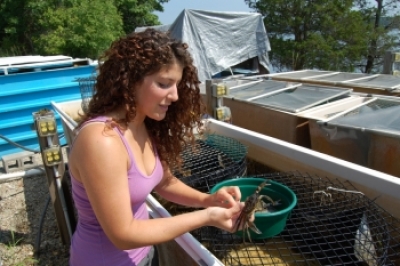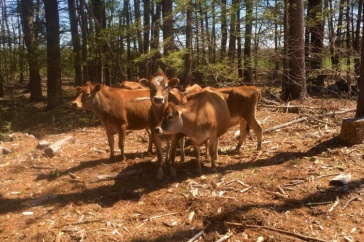
Last summer, Erika Moretti ’15 was on a lobster boat on Great Bay helping a UNH researcher pull lobster traps for an annual survey when they found a blue crab in one of the pots. Green crabs are often mixed in with the catch; blue crabs are not. They don’t like cold water.
But it turned out, Moretti later learned, that local oyster researchers had discovered a few of the blue crustaceans in their oyster beds and that they were eating the oysters. That cinched it for Moretti, a senior majoring in zoology. She crafted a proposal for a Summer Undergraduate Research Fellowship (SURF) grant through UNH's Hamel Center for Undergraduate Research, outlining her interest in studying the crabs and their green counterparts, hoping to learn how they might impact Great Bay’s lobster population.
“I love research. I’ve always been into science,” says Moretti, who spent last summer as a research assistant working with Win Watson, UNH’s associate director of education of the School of Marine Science and Ocean Engineering and professor of zoology.
This year, with support of the 10-week SURF grant, the Salem, N.H. native has been conducting her own research, trying to learn what would happen if the blue crab population increased. Would they prey on the invasive green crab—something Moretti says would be good for Great Bay because the green crabs destroy the eelgrass, critical to the 6,000-acre estuary’s habitat. Would the blue crabs eat the small lobsters as the green crabs do, possibility leading to reduced supply? And what about those pesky green crabs? Would they attack their blue cousins?
To find those answers, she decided to force the species to live together. Working at Jackson Estuarine Laboratory at Adams Point in Durham, she built three mesh enclosures to house the crabs and lobsters, mixing up the test size: a large lobster with a small blue crab; a blue crab with a smaller green crab, etc.
Moretti set the three enclosures inside a large tank filled with bay water and placed a camera that snaps pictures every two seconds above the tank to record the activity. She added red lights to see what happened after dark.
“A lot goes on at night,” Moretti says. “I saw the lobster going after a small green crab, and the crab going after the lobster—whichever one is bigger has been dominating.”
One sequence of photos, appearing like a video because of how fast they are shot, shows a young lobster and a blue crab stalking one another.
“They spent the entire time trying to figure each other out. They were definitely trying to establish who was dominant. But by the end of the night, the blue crab had the run of the tank,” Moretti says. “You could assume that the young lobster had never seen a blue crab in its life, so that could be part of it.”
Then she swapped out the young lobster for a larger one.
“Unfortunately for the blue crab, the big lobster proved to be too much for him. I found the lobster alive and very aggressive, surrounded by pieces of the blue crab's shell,” Moretti says.
The experiments are giving Moretti a better idea of how lobsters and crabs interact in close quarters, and what factors might influence the exchanges. If she feeds them, for example, and one is aggressive, she can assume it isn’t because it is hungry. She will also test changes in habitat, shelter and what happens when she places all three species in one tank.
"My main focus is the ecology of the three species, and how their interactions might affect the local populations of lobsters, which would, in turn, affect the industry," she says, adding, "I like that it's my own research and that I've been able to run with it. I came up with the idea and it's been great to see it play out—to be responsible for the outcome."
Moretti says she has known what she wanted to do since taking a zoology class at Salem High School, one of the few high schools in New Hampshire that offers zoology. And UNH, she says, is one of two state colleges in New England where the subject is available as a major.
In the fall, Moretti will sit down with Watson to discuss her research, which she plans to continue throughout the coming school year. “I want to see where I can go from here,” she says. “There is still so much to learn. That’s the thing I love about research—you don’t know where it will lead.”
Related:
-
Written By:
Jody Record ’95 | Communications and Public Affairs | jody.record@unh.edu



















































